【名师导航】Unit 6 Movies and Theater早读过关知识清单(冀教九上)
文档属性
| 名称 | 【名师导航】Unit 6 Movies and Theater早读过关知识清单(冀教九上) | 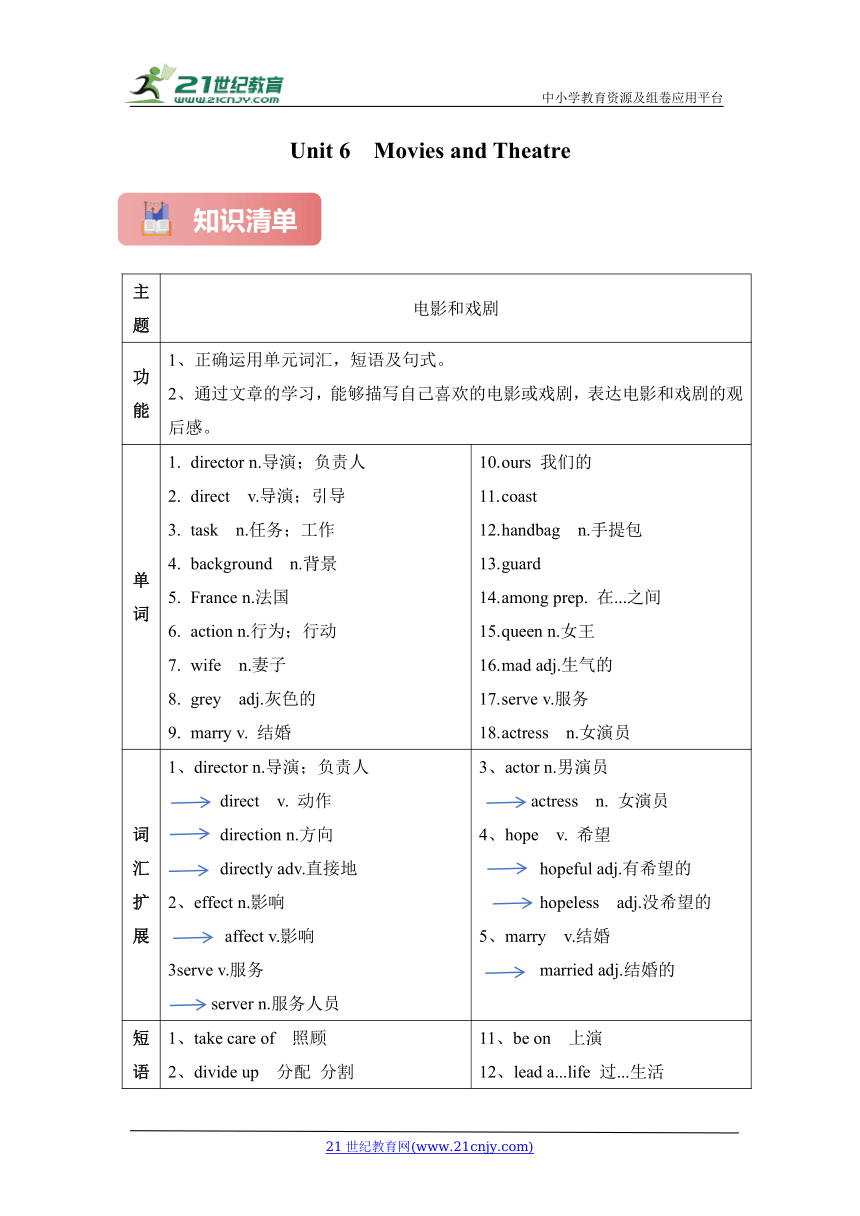 | |
| 格式 | docx | ||
| 文件大小 | 111.3KB | ||
| 资源类型 | 试卷 | ||
| 版本资源 | 冀教版 | ||
| 科目 | 英语 | ||
| 更新时间 | 2023-12-26 16:22:56 | ||
图片预览

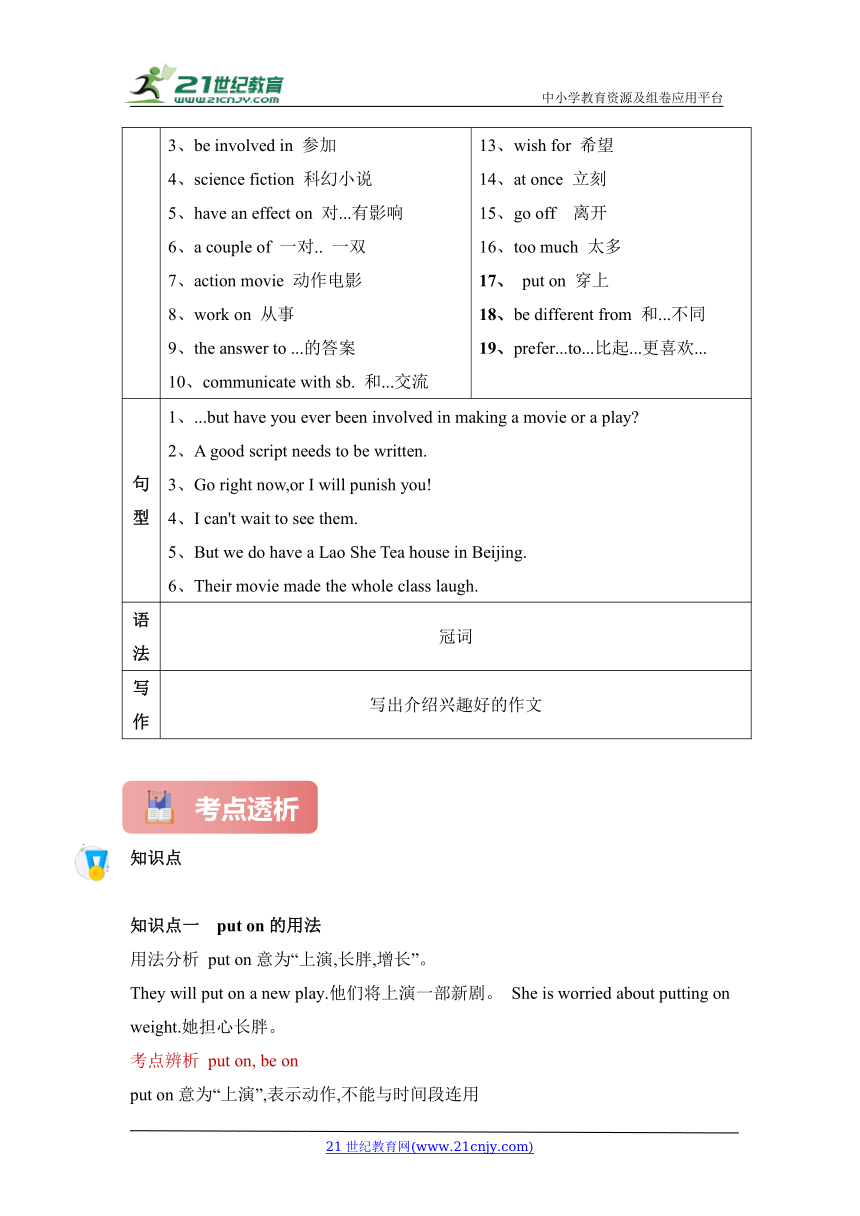
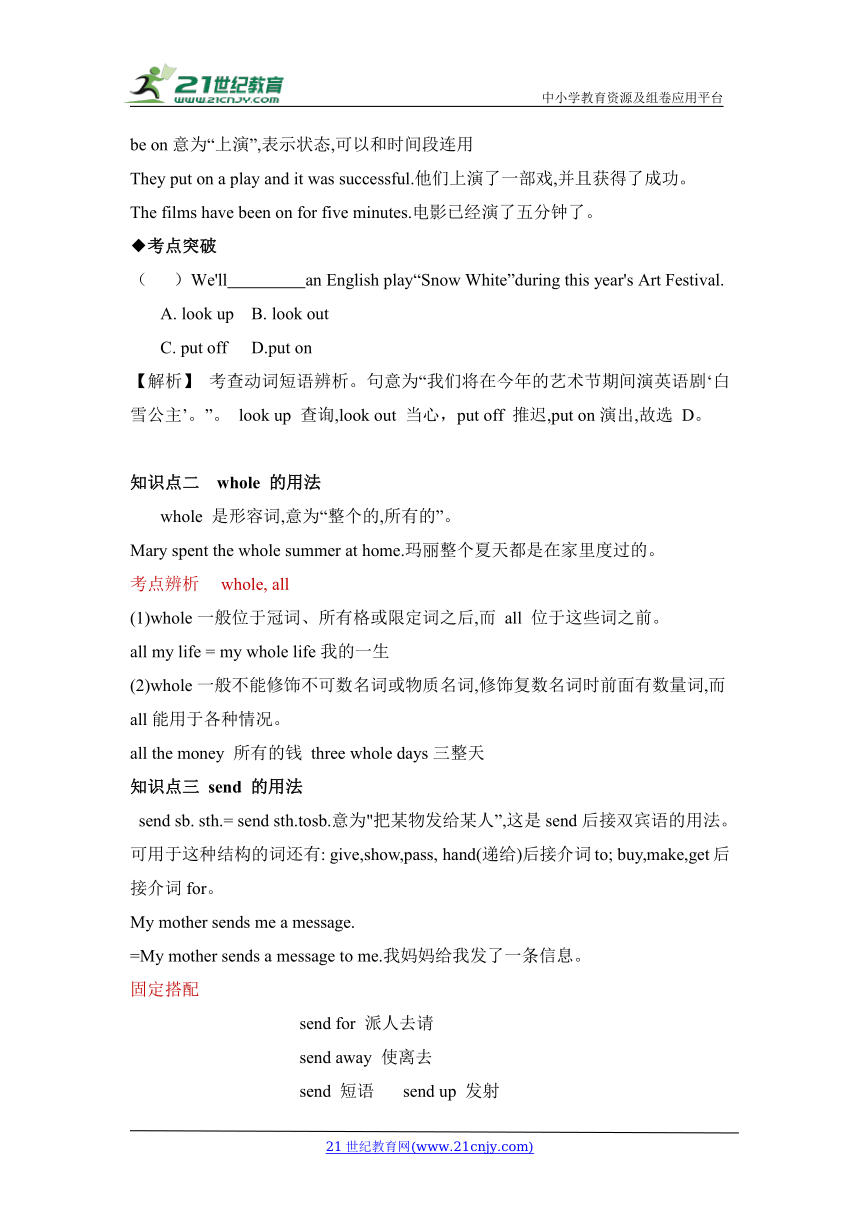
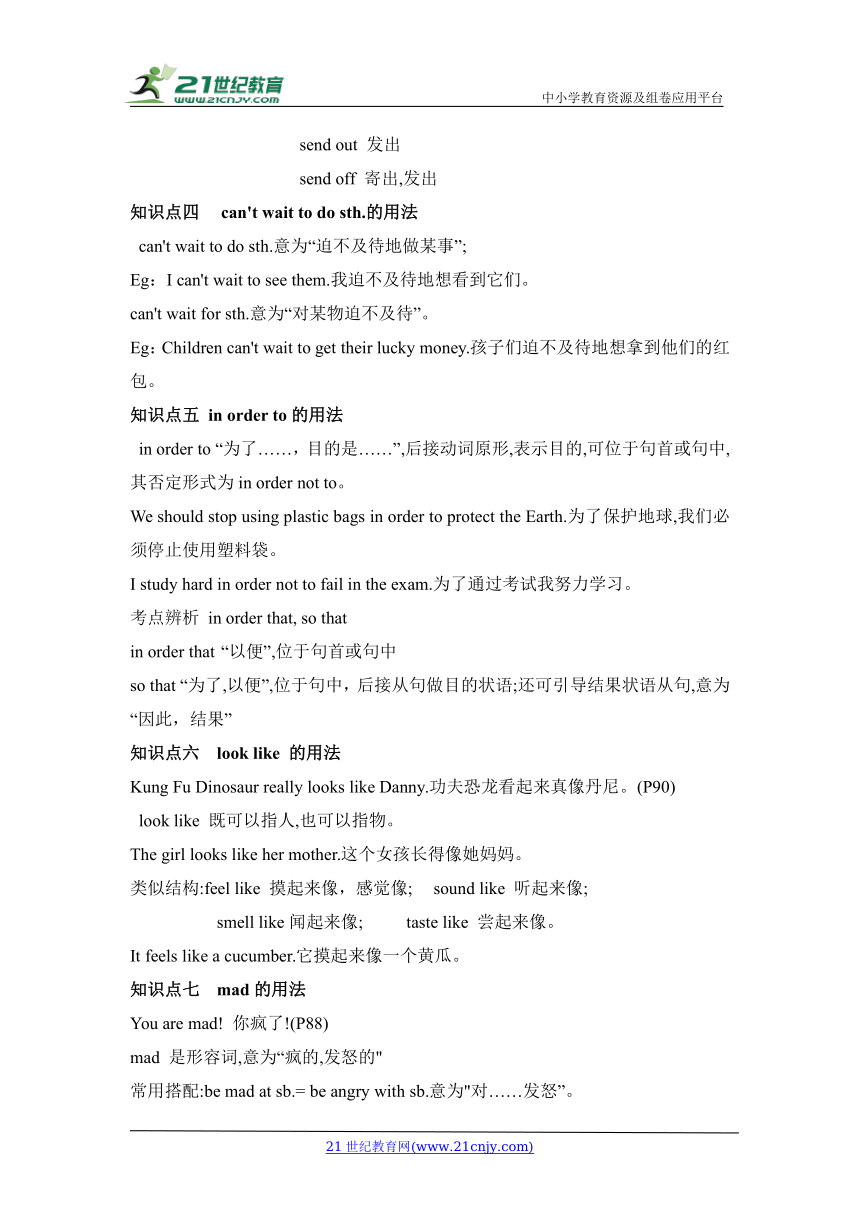
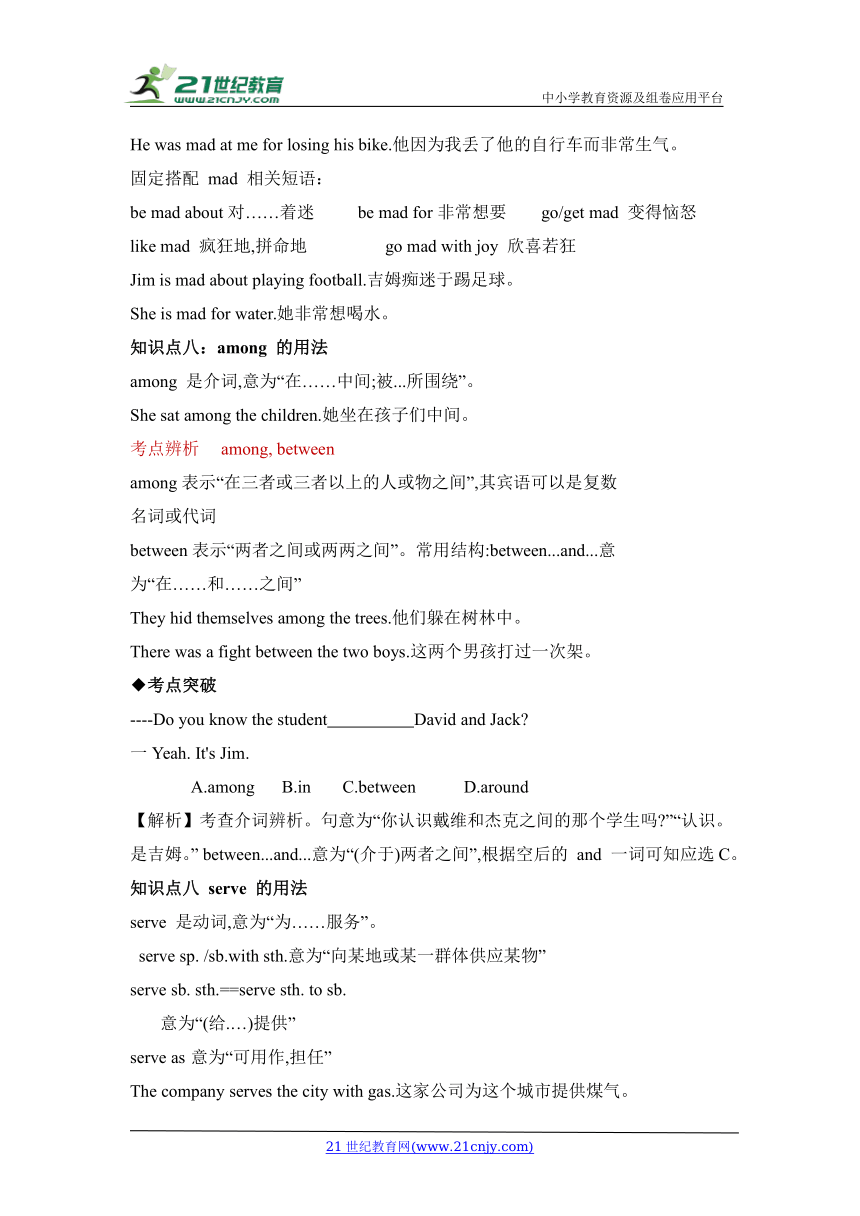
文档简介
中小学教育资源及组卷应用平台
Unit 6 Movies and Theatre
主题 电影和戏剧
功能 正确运用单元词汇,短语及句式。 通过文章的学习,能够描写自己喜欢的电影或戏剧,表达电影和戏剧的观后感。
单词 director n.导演;负责人 direct v.导演;引导 task n.任务;工作 background n.背景 France n.法国 action n.行为;行动 wife n.妻子 grey adj.灰色的 marry v. 结婚 ours 我们的 coast handbag n.手提包 guard among prep. 在...之间 queen n.女王 mad adj.生气的 serve v.服务 actress n.女演员
词汇扩展 director n.导演;负责人 direct v. 动作 direction n.方向 directly adv.直接地 2、effect n.影响 affect v.影响 3serve v.服务 server n.服务人员 actor n.男演员 actress n. 女演员 hope v. 希望 hopeful adj.有希望的 hopeless adj.没希望的 marry v.结婚 married adj.结婚的
短语 take care of 照顾 divide up 分配 分割 be involved in 参加 science fiction 科幻小说 have an effect on 对...有影响 a couple of 一对.. 一双 action movie 动作电影 work on 从事 the answer to ...的答案 communicate with sb. 和...交流 be on 上演 lead a...life 过...生活 wish for 希望 at once 立刻 go off 离开 too much 太多 put on 穿上 be different from 和...不同 prefer...to...比起...更喜欢...
句型 ...but have you ever been involved in making a movie or a play A good script needs to be written. Go right now,or I will punish you! I can't wait to see them. But we do have a Lao She Tea house in Beijing. Their movie made the whole class laugh.
语法 冠词
写作 写出介绍兴趣好的作文
知识点
知识点一 put on的用法
用法分析 put on意为“上演,长胖,增长”。
They will put on a new play.他们将上演一部新剧。 She is worried about putting on weight.她担心长胖。
考点辨析 put on, be on
put on意为“上演”,表示动作,不能与时间段连用
be on意为“上演”,表示状态,可以和时间段连用
They put on a play and it was successful.他们上演了一部戏,并且获得了成功。
The films have been on for five minutes.电影已经演了五分钟了。
◆考点突破
( )We'll an English play“Snow White”during this year's Art Festival.
A. look up B. look out
C. put off D.put on
【解析】 考查动词短语辨析。句意为“我们将在今年的艺术节期间演英语剧‘白雪公主’。”。 look up 查询,look out 当心,put off 推迟,put on演出,故选 D。
知识点二 whole 的用法
whole 是形容词,意为“整个的,所有的”。
Mary spent the whole summer at home.玛丽整个夏天都是在家里度过的。
考点辨析 whole, all
(1)whole一般位于冠词、所有格或限定词之后,而 all 位于这些词之前。
all my life = my whole life我的一生
(2)whole一般不能修饰不可数名词或物质名词,修饰复数名词时前面有数量词,而all能用于各种情况。
all the money 所有的钱 three whole days三整天
知识点三 send 的用法
send sb. sth.= send sth.tosb.意为"把某物发给某人”,这是send后接双宾语的用法。
可用于这种结构的词还有: give,show,pass, hand(递给)后接介词to; buy,make,get后接介词for。
My mother sends me a message.
=My mother sends a message to me.我妈妈给我发了一条信息。
固定搭配
send for 派人去请
send away 使离去
send 短语 send up 发射
send out 发出
send off 寄出,发出
知识点四 can't wait to do sth.的用法
can't wait to do sth.意为“迫不及待地做某事”;
Eg:I can't wait to see them.我迫不及待地想看到它们。
can't wait for sth.意为“对某物迫不及待”。
Eg:Children can't wait to get their lucky money.孩子们迫不及待地想拿到他们的红包。
知识点五 in order to的用法
in order to “为了……,目的是……”,后接动词原形,表示目的,可位于句首或句中,其否定形式为in order not to。
We should stop using plastic bags in order to protect the Earth.为了保护地球,我们必须停止使用塑料袋。
I study hard in order not to fail in the exam.为了通过考试我努力学习。
考点辨析 in order that, so that
in order that “以便”,位于句首或句中
so that “为了,以便”,位于句中,后接从句做目的状语;还可引导结果状语从句,意为“因此,结果”
知识点六 look like 的用法
Kung Fu Dinosaur really looks like Danny.功夫恐龙看起来真像丹尼。(P90)
look like 既可以指人,也可以指物。
The girl looks like her mother.这个女孩长得像她妈妈。
类似结构:feel like 摸起来像,感觉像; sound like 听起来像;
smell like闻起来像; taste like 尝起来像。
It feels like a cucumber.它摸起来像一个黄瓜。
知识点七 mad的用法
You are mad! 你疯了!(P88)
mad 是形容词,意为“疯的,发怒的"
常用搭配:be mad at sb.= be angry with sb.意为"对……发怒”。
He was mad at me for losing his bike.他因为我丢了他的自行车而非常生气。
固定搭配 mad 相关短语:
be mad about对……着迷 be mad for非常想要 go/get mad 变得恼怒
like mad 疯狂地,拼命地 go mad with joy 欣喜若狂
Jim is mad about playing football.吉姆痴迷于踢足球。
She is mad for water.她非常想喝水。
知识点八:among 的用法
among 是介词,意为“在……中间;被...所围绕”。
She sat among the children.她坐在孩子们中间。
考点辨析 among, between
among表示“在三者或三者以上的人或物之间”,其宾语可以是复数
名词或代词
between表示“两者之间或两两之间”。常用结构:between...and...意
为“在……和……之间”
They hid themselves among the trees.他们躲在树林中。
There was a fight between the two boys.这两个男孩打过一次架。
◆考点突破
----Do you know the student David and Jack
一Yeah. It's Jim.
A.among B.in C.between D.around
【解析】考查介词辨析。句意为“你认识戴维和杰克之间的那个学生吗 ”“认识。是吉姆。” between...and...意为“(介于)两者之间”,根据空后的 and 一词可知应选C。
知识点八 serve 的用法
serve 是动词,意为“为……服务”。
serve sp. /sb.with sth.意为“向某地或某一群体供应某物”
serve sb. sth.==serve sth. to sb.
意为“(给.…)提供”
serve as 意为“可用作,担任”
The company serves the city with gas.这家公司为这个城市提供煤气。
They served a meal to more than fifty guests.他们招待了五十多位客人。
知识点九 go off 的用法
考点辨析go off, turn off
go off 意为“(灯)熄灭,(电)中断,(闹铃)响,停止运行”,主语是物
turn off 意为“关掉(电器、煤气等)”,主 语是人
The heating went off at night.暖气夜间停止供热。 The candle went off. 蜡烛熄灭了。
You should turn off the lights when you leave the room.当你离开房间时应该关灯。
◆考点突破
( )1、The boss was late the meeting because his alarm clock didn't .
A. go off B. go out C.go on
【解析】考查动词短语辨析。句意为“老板开会迟到了,因为他的闹铃没有响。”
go off 闹铃响,go out 出去,go on 继续,故选 A。
( )2、一Sally,it's already 10:0o pm. It's time for you to go to bed.
---OK, Dad. I'll turn the TV right now.
A.on B.down C.off
【解析】 考查动词短语辨析。句意为“萨利,已经晚上10点了。你该睡觉了。“好的,爸爸。我将立即关掉电视。”
turn on 打开,turn down调低,turn off 关闭,故选C。
知识点十 wife 的用法
wife 是可数名词,意为“妻子”,复数形式是 wives,对应词为 husband。
His wife is cleaning the room now.他的妻子正在打扫房间。
类似复数变化的词还有:
妻子(wife)持刀(knife)去宰狼(wolf),小偷(thief)吓得发了慌;躲在架(shelf)后保己(self)命( life),半(half)片树叶(leaf)遮目光。
知识点十一 动名词做主语的用法
Watching a great movie while eating popcorn 是动名词短语在句中做主语,此时谓语动词用单数形式。
◆考点突破
( ) vegetable juice is a good habit, which helps you eat a balanced diet.
A. Drink B.Drank C.Drunk D.Drinking
【解析】考查动名词做主语的用法。句意:喝蔬 菜汁是个好习惯,可以帮助你均衡饮食,故选 D。
知识点十二 interested 的用法
be interested in = take interest in意为“对……感兴趣”,后接名词或动名词。
考点辨析 interesting, interested
interesting意为“有趣的”,描述事物本身的特性。主语通常是物,可以
做表语或定语
interested意为“感兴趣的”,用于描述人的情感。主语通常是人,常用
于be interested in结构
interesting的用法
The movie is very interesting.这部电影很有趣。 I'm interested in swimming.我对游泳感兴趣。
考点拓展用法相似的形容词:
动词 形容词 形容词
Excite exciting (令人兴奋的) excited (感到兴奋的)
move moving (令人感动的) moved(感动的)
Surprise surprising (令(感到人惊讶的) surprised(惊讶的)
Amaze amazing (令人惊奇的) amazed (感到惊奇的)
tire tiring (使人疲倦的) tired(疲倦的)
bore boring(令人厌倦的) bored(厌倦的)
relax relaxing (令人放松的) relaxed(放松的)
interest interesting(有趣的) interested (感兴趣的)
◆考点突破
( )Bob takes interest in taking photos of sea birds.(同义替换)
A. is interested in B. is interesting C. is good at D. is tired of
【解析】考查近义词组辨析。句意:Bob 对扌海鸟感兴趣。take interest in意为“对……感趣”,同义词组是be interested in,故选 A。
语法点
宾语补足语
宾语补足语是在及物动词后面,用来对宾语进行进一步说明或补充的成分。它通常是形容词、名词、介词短语或不定式短语等。宾语补足语在句子中起到修饰或补充宾语的作用,使句子更加完整和丰富。
明宾语补足语的不同类型:
形容词 (Adjective):
例句:她觉得这本书很有趣。 (She finds this book very interesting.)
在这个例子中,"很有趣" 是形容词短语,修饰宾语 "这本书",进一步说明了她的感受。
名词 (Noun):
例句:他认为她是一个天才。 (He thinks she is a genius.)
这里,"一个天才" 是名词短语,作为宾语 "她" 的补足语,指代并描述了她的才华。
不定式做宾语补足语,表示宾语要做的动作。
(1)常见接带to 的动词不定式做宾语补足语的动词有: ask,tell, want, teach, wish, warn, invite, encourage 等。
We consider him ( to be)a good teacher.我们认为他是一个好老师。
(2)下列动词后接不定式做宾语补足语时常省略 to:一感(feel),二听(listen to, hear),三让(let,make, have),四观看(see, watch,observe, notice)。但是转为被动语态时,to要还原。
She made him give up smoking.她让他戒了烟。 Though he had often made his little sister cry, today he was made to cry by his little sister.虽然经常是他弄哭小妹妹,但今天他却被小妹妹弄哭了。
现在分词做宾语补足语,表示宾语正在进行的动作。
They felt the car moving fast.他们感到小汽车行驶得很快。
过去分词做宾语补足语,表示与宾语之间为被动关系。
I will have my bike repaired tomorrow.我明天要找人修自行车。
介词短语或副词短语做宾语补足语。
Keep the dog in the yard.让狗待在院子里。
在复合宾语中,宾语由it 充当,真正的宾语移到句子后面,句型结构:主语+谓语+it(形式宾语)+宾语补足语(形容词/名词)+动词不定式。常用于这种结构的动词有: feel, find, think, make, take, judge, consider 等。
I find it important to learn English well.我发现学好英语很重要。
副词 (Adverb):
例句:她把饭做得很快。 (She cooks the meal quickly.)
在这个例子中,"很快" 是副词短语,修饰宾语 "饭",表示动作的速度。
形容词从句 (Adjective Clause):
例句:我发现他喜欢的那个城市非常美丽。 (I found that the city he likes is very beautiful.)
这里,"他喜欢的那个城市" 是形容词从句,作为宾语 "城市" 的补足语,进一步描述了城市的属性。
◆考点突破
The news made him __________.
sad B. sadly C. to be sad D. sadness
【答案】A
【解析】"Made" 后需要一个形容词来描述 "him" 的感觉,而 "sad" 恰好是合适的形容词,表示这个消息让他感到悲伤。
The teacher found the students __________ during the lecture.
asleep B. sleep C. to sleep D. sleeping
【答案】A
【解析】在这里,"found" 后面需要一个形容词,表示学生的状态。"Asleep" 是形容词,表示学生们在讲座中是处于睡眠状态的。
He apologized __________ his mistake.
A. for making B. making C. to make D. make
【答案】A
【解析】"Apologized" 后需要一个介词短语,表示道歉的原因。"For making" 表示因为犯了错误而道歉。
被动语态
被动语态在不同时态中的构造会随着时态的变化而调整,主要涉及助动词 "be" 的不同时态形式。
以下是被动语态在一般现在时、一般过去时,现在进行时,一般将来时和过去进行时中的构造:
一般现在时:am/is/are+动词的过去分词(done)
主动语态:They build houses.(他们建房子。)
被动语态:Houses are built by them.(房子被他们建。)
一般过去时:was/were+动词的过去分词(done)
主动语态:They built houses.(他们建房子。)
被动语态:Houses were built by them.(房子被他们建。)
一般将来时:will be+动词的过去分词(done)
主动语态:They will build houses.(他们将建房子。)
被动语态:Houses will be built by them.(房子将被他们建。)
现在进行时:am/is/are being+动词的过去分词(done)
主动语态:They are building houses.(他们正在建房子。)
被动语态:Houses are being built by them.(房子正在被他们建。)
过去进行时:was/were being+动词的过去分词(done)
主动语态:They were building houses.(他们正在建房子。)
被动语态:Houses were being built by them.(房子正在被他们建。)
这里的 "被" 和 "执行者" 可以省略,具体是否省略通常取决于句子中是否需要强调执行者。被动语态的时态构造主要通过助动词 "be" 的不同形式来实现。
二、基本用法
1.为了强调或者突出动作的承受者时。 The glass was broken.玻璃被打破了。
2.当不知道或没有必要说明动作的执行者时, This book is written for children.这本书是为孩子们写的。
3.出于礼貌或为了表示婉转的语气等不愿说出动作的执行者时。
All the work must be finished.所有的工作必须完成。
4.动作的执行者是泛指或不言自明时。
English is spoken all over the world. 全世界的人都说英语。
注意:在被动语态中,当需要指出动作的执行者时,由介词 by 引出。
The little boy was saved by a policeman.这个小男孩被警察救了。
三、主动语态变被动语态的方法
1.将宾语变成主语。
2.将谓语变成被动结构,时态要和原主动语态一致。
3.原主语如果有必要留下,则用by 引导,放在动词之后或句末,且将主格改为宾格。
Many people use the Internet.
→The Internet is used by many people.
主动结构表示被动含义
1、主语通常是无生命的名词或代词时,可以和well ,easily,smoothly等副词连用的动词,如break. catch, clean , drive , lock , open, sell, read, write , wash 等常用其主动形式表达被动意义。
The door won't lock.门锁不了。
The book sells well.这本书卖得很好。
2. happen, take place , come out , come true等表示“出现”,“发生”之类的词或词组以主动形式表示被动意义。句
How do the newspapers come out 这些报纸是如何印出来的呢
3.感官动词 feel, sound, taste等的主动形式表示被动意义。
Your reason sounds reasonable.你的理由听起来
吾 是合理的。
4. want, need, require等动词后面接动名词表示被动意义,其用法相当于“need/require /... + to be done”。
All the computers need repairing.
=All the computers need to be repaired.所有的电脑都需要修理。
5. worth 后面接动名词的主动形式表示被动含义;而worthy 后面接动词不定式的被动形式。
The picture-book is well worth reading.
=The picture-book is very worthy to be read.这本书非常值得阅读。
6.在 there be 句型中,当动词不定式修饰名词做定语时,不定式用主动形式做定语,重点在人;用被动形式做定语,重点在物。
There is no time to waste/to be wasted.没有时间去浪费。
7.在某些“形容词+不定式”做表语或宾语补足语的结构中,句子的主语或宾语又是动词不定式的逻辑宾语时,这时常用不定式的主动形式表达被动意义。这些形容词有:nice,easy, fit, hard, difficult, important, impossible, pleasant , interesting等。
This problem is difficult to work out. 这个问题很难解决。
8.在 too...to...结构中,不定式前面可加逻辑主语,用主动形式表示被动意义。
This book is too expensive for me to buy.这本书对我来说太贵了,买不起。
◆考点突破
The report __________ by the team.
is writing B. is being written
C. has written D. has been written
【答案】B
【解析】这是一般现在时的被动语态。正确的形式是 "is being written",强调正在进行的动作。
A new library __________ in the town last year.
A. builds B. is building C. was built D. has built
【答案】C
【解析】这是一般过去时的被动语态。正确的形式是 "was built",表示在过去发生的动作。
The letter __________ before I arrived.
A. wrote B. is written C. was writing d. had been written
【答案】D
【解析】这是过去完成时的被动语态。正确的形式是 "had been written",表示在过去某一时间之前已经完成的动作。
English __________ by millions of people around the world.
A. speak B. is spoken C. was spoken D. speaks
【答案】B
【解析】这是一般现在时的被动语态。正确的形式是 "is spoken",表示一种普遍的事实,即英语被全世界数百万人使用。
21世纪教育网(www.21cnjy.com)
Unit 6 Movies and Theatre
主题 电影和戏剧
功能 正确运用单元词汇,短语及句式。 通过文章的学习,能够描写自己喜欢的电影或戏剧,表达电影和戏剧的观后感。
单词 director n.导演;负责人 direct v.导演;引导 task n.任务;工作 background n.背景 France n.法国 action n.行为;行动 wife n.妻子 grey adj.灰色的 marry v. 结婚 ours 我们的 coast handbag n.手提包 guard among prep. 在...之间 queen n.女王 mad adj.生气的 serve v.服务 actress n.女演员
词汇扩展 director n.导演;负责人 direct v. 动作 direction n.方向 directly adv.直接地 2、effect n.影响 affect v.影响 3serve v.服务 server n.服务人员 actor n.男演员 actress n. 女演员 hope v. 希望 hopeful adj.有希望的 hopeless adj.没希望的 marry v.结婚 married adj.结婚的
短语 take care of 照顾 divide up 分配 分割 be involved in 参加 science fiction 科幻小说 have an effect on 对...有影响 a couple of 一对.. 一双 action movie 动作电影 work on 从事 the answer to ...的答案 communicate with sb. 和...交流 be on 上演 lead a...life 过...生活 wish for 希望 at once 立刻 go off 离开 too much 太多 put on 穿上 be different from 和...不同 prefer...to...比起...更喜欢...
句型 ...but have you ever been involved in making a movie or a play A good script needs to be written. Go right now,or I will punish you! I can't wait to see them. But we do have a Lao She Tea house in Beijing. Their movie made the whole class laugh.
语法 冠词
写作 写出介绍兴趣好的作文
知识点
知识点一 put on的用法
用法分析 put on意为“上演,长胖,增长”。
They will put on a new play.他们将上演一部新剧。 She is worried about putting on weight.她担心长胖。
考点辨析 put on, be on
put on意为“上演”,表示动作,不能与时间段连用
be on意为“上演”,表示状态,可以和时间段连用
They put on a play and it was successful.他们上演了一部戏,并且获得了成功。
The films have been on for five minutes.电影已经演了五分钟了。
◆考点突破
( )We'll an English play“Snow White”during this year's Art Festival.
A. look up B. look out
C. put off D.put on
【解析】 考查动词短语辨析。句意为“我们将在今年的艺术节期间演英语剧‘白雪公主’。”。 look up 查询,look out 当心,put off 推迟,put on演出,故选 D。
知识点二 whole 的用法
whole 是形容词,意为“整个的,所有的”。
Mary spent the whole summer at home.玛丽整个夏天都是在家里度过的。
考点辨析 whole, all
(1)whole一般位于冠词、所有格或限定词之后,而 all 位于这些词之前。
all my life = my whole life我的一生
(2)whole一般不能修饰不可数名词或物质名词,修饰复数名词时前面有数量词,而all能用于各种情况。
all the money 所有的钱 three whole days三整天
知识点三 send 的用法
send sb. sth.= send sth.tosb.意为"把某物发给某人”,这是send后接双宾语的用法。
可用于这种结构的词还有: give,show,pass, hand(递给)后接介词to; buy,make,get后接介词for。
My mother sends me a message.
=My mother sends a message to me.我妈妈给我发了一条信息。
固定搭配
send for 派人去请
send away 使离去
send 短语 send up 发射
send out 发出
send off 寄出,发出
知识点四 can't wait to do sth.的用法
can't wait to do sth.意为“迫不及待地做某事”;
Eg:I can't wait to see them.我迫不及待地想看到它们。
can't wait for sth.意为“对某物迫不及待”。
Eg:Children can't wait to get their lucky money.孩子们迫不及待地想拿到他们的红包。
知识点五 in order to的用法
in order to “为了……,目的是……”,后接动词原形,表示目的,可位于句首或句中,其否定形式为in order not to。
We should stop using plastic bags in order to protect the Earth.为了保护地球,我们必须停止使用塑料袋。
I study hard in order not to fail in the exam.为了通过考试我努力学习。
考点辨析 in order that, so that
in order that “以便”,位于句首或句中
so that “为了,以便”,位于句中,后接从句做目的状语;还可引导结果状语从句,意为“因此,结果”
知识点六 look like 的用法
Kung Fu Dinosaur really looks like Danny.功夫恐龙看起来真像丹尼。(P90)
look like 既可以指人,也可以指物。
The girl looks like her mother.这个女孩长得像她妈妈。
类似结构:feel like 摸起来像,感觉像; sound like 听起来像;
smell like闻起来像; taste like 尝起来像。
It feels like a cucumber.它摸起来像一个黄瓜。
知识点七 mad的用法
You are mad! 你疯了!(P88)
mad 是形容词,意为“疯的,发怒的"
常用搭配:be mad at sb.= be angry with sb.意为"对……发怒”。
He was mad at me for losing his bike.他因为我丢了他的自行车而非常生气。
固定搭配 mad 相关短语:
be mad about对……着迷 be mad for非常想要 go/get mad 变得恼怒
like mad 疯狂地,拼命地 go mad with joy 欣喜若狂
Jim is mad about playing football.吉姆痴迷于踢足球。
She is mad for water.她非常想喝水。
知识点八:among 的用法
among 是介词,意为“在……中间;被...所围绕”。
She sat among the children.她坐在孩子们中间。
考点辨析 among, between
among表示“在三者或三者以上的人或物之间”,其宾语可以是复数
名词或代词
between表示“两者之间或两两之间”。常用结构:between...and...意
为“在……和……之间”
They hid themselves among the trees.他们躲在树林中。
There was a fight between the two boys.这两个男孩打过一次架。
◆考点突破
----Do you know the student David and Jack
一Yeah. It's Jim.
A.among B.in C.between D.around
【解析】考查介词辨析。句意为“你认识戴维和杰克之间的那个学生吗 ”“认识。是吉姆。” between...and...意为“(介于)两者之间”,根据空后的 and 一词可知应选C。
知识点八 serve 的用法
serve 是动词,意为“为……服务”。
serve sp. /sb.with sth.意为“向某地或某一群体供应某物”
serve sb. sth.==serve sth. to sb.
意为“(给.…)提供”
serve as 意为“可用作,担任”
The company serves the city with gas.这家公司为这个城市提供煤气。
They served a meal to more than fifty guests.他们招待了五十多位客人。
知识点九 go off 的用法
考点辨析go off, turn off
go off 意为“(灯)熄灭,(电)中断,(闹铃)响,停止运行”,主语是物
turn off 意为“关掉(电器、煤气等)”,主 语是人
The heating went off at night.暖气夜间停止供热。 The candle went off. 蜡烛熄灭了。
You should turn off the lights when you leave the room.当你离开房间时应该关灯。
◆考点突破
( )1、The boss was late the meeting because his alarm clock didn't .
A. go off B. go out C.go on
【解析】考查动词短语辨析。句意为“老板开会迟到了,因为他的闹铃没有响。”
go off 闹铃响,go out 出去,go on 继续,故选 A。
( )2、一Sally,it's already 10:0o pm. It's time for you to go to bed.
---OK, Dad. I'll turn the TV right now.
A.on B.down C.off
【解析】 考查动词短语辨析。句意为“萨利,已经晚上10点了。你该睡觉了。“好的,爸爸。我将立即关掉电视。”
turn on 打开,turn down调低,turn off 关闭,故选C。
知识点十 wife 的用法
wife 是可数名词,意为“妻子”,复数形式是 wives,对应词为 husband。
His wife is cleaning the room now.他的妻子正在打扫房间。
类似复数变化的词还有:
妻子(wife)持刀(knife)去宰狼(wolf),小偷(thief)吓得发了慌;躲在架(shelf)后保己(self)命( life),半(half)片树叶(leaf)遮目光。
知识点十一 动名词做主语的用法
Watching a great movie while eating popcorn 是动名词短语在句中做主语,此时谓语动词用单数形式。
◆考点突破
( ) vegetable juice is a good habit, which helps you eat a balanced diet.
A. Drink B.Drank C.Drunk D.Drinking
【解析】考查动名词做主语的用法。句意:喝蔬 菜汁是个好习惯,可以帮助你均衡饮食,故选 D。
知识点十二 interested 的用法
be interested in = take interest in意为“对……感兴趣”,后接名词或动名词。
考点辨析 interesting, interested
interesting意为“有趣的”,描述事物本身的特性。主语通常是物,可以
做表语或定语
interested意为“感兴趣的”,用于描述人的情感。主语通常是人,常用
于be interested in结构
interesting的用法
The movie is very interesting.这部电影很有趣。 I'm interested in swimming.我对游泳感兴趣。
考点拓展用法相似的形容词:
动词 形容词 形容词
Excite exciting (令人兴奋的) excited (感到兴奋的)
move moving (令人感动的) moved(感动的)
Surprise surprising (令(感到人惊讶的) surprised(惊讶的)
Amaze amazing (令人惊奇的) amazed (感到惊奇的)
tire tiring (使人疲倦的) tired(疲倦的)
bore boring(令人厌倦的) bored(厌倦的)
relax relaxing (令人放松的) relaxed(放松的)
interest interesting(有趣的) interested (感兴趣的)
◆考点突破
( )Bob takes interest in taking photos of sea birds.(同义替换)
A. is interested in B. is interesting C. is good at D. is tired of
【解析】考查近义词组辨析。句意:Bob 对扌海鸟感兴趣。take interest in意为“对……感趣”,同义词组是be interested in,故选 A。
语法点
宾语补足语
宾语补足语是在及物动词后面,用来对宾语进行进一步说明或补充的成分。它通常是形容词、名词、介词短语或不定式短语等。宾语补足语在句子中起到修饰或补充宾语的作用,使句子更加完整和丰富。
明宾语补足语的不同类型:
形容词 (Adjective):
例句:她觉得这本书很有趣。 (She finds this book very interesting.)
在这个例子中,"很有趣" 是形容词短语,修饰宾语 "这本书",进一步说明了她的感受。
名词 (Noun):
例句:他认为她是一个天才。 (He thinks she is a genius.)
这里,"一个天才" 是名词短语,作为宾语 "她" 的补足语,指代并描述了她的才华。
不定式做宾语补足语,表示宾语要做的动作。
(1)常见接带to 的动词不定式做宾语补足语的动词有: ask,tell, want, teach, wish, warn, invite, encourage 等。
We consider him ( to be)a good teacher.我们认为他是一个好老师。
(2)下列动词后接不定式做宾语补足语时常省略 to:一感(feel),二听(listen to, hear),三让(let,make, have),四观看(see, watch,observe, notice)。但是转为被动语态时,to要还原。
She made him give up smoking.她让他戒了烟。 Though he had often made his little sister cry, today he was made to cry by his little sister.虽然经常是他弄哭小妹妹,但今天他却被小妹妹弄哭了。
现在分词做宾语补足语,表示宾语正在进行的动作。
They felt the car moving fast.他们感到小汽车行驶得很快。
过去分词做宾语补足语,表示与宾语之间为被动关系。
I will have my bike repaired tomorrow.我明天要找人修自行车。
介词短语或副词短语做宾语补足语。
Keep the dog in the yard.让狗待在院子里。
在复合宾语中,宾语由it 充当,真正的宾语移到句子后面,句型结构:主语+谓语+it(形式宾语)+宾语补足语(形容词/名词)+动词不定式。常用于这种结构的动词有: feel, find, think, make, take, judge, consider 等。
I find it important to learn English well.我发现学好英语很重要。
副词 (Adverb):
例句:她把饭做得很快。 (She cooks the meal quickly.)
在这个例子中,"很快" 是副词短语,修饰宾语 "饭",表示动作的速度。
形容词从句 (Adjective Clause):
例句:我发现他喜欢的那个城市非常美丽。 (I found that the city he likes is very beautiful.)
这里,"他喜欢的那个城市" 是形容词从句,作为宾语 "城市" 的补足语,进一步描述了城市的属性。
◆考点突破
The news made him __________.
sad B. sadly C. to be sad D. sadness
【答案】A
【解析】"Made" 后需要一个形容词来描述 "him" 的感觉,而 "sad" 恰好是合适的形容词,表示这个消息让他感到悲伤。
The teacher found the students __________ during the lecture.
asleep B. sleep C. to sleep D. sleeping
【答案】A
【解析】在这里,"found" 后面需要一个形容词,表示学生的状态。"Asleep" 是形容词,表示学生们在讲座中是处于睡眠状态的。
He apologized __________ his mistake.
A. for making B. making C. to make D. make
【答案】A
【解析】"Apologized" 后需要一个介词短语,表示道歉的原因。"For making" 表示因为犯了错误而道歉。
被动语态
被动语态在不同时态中的构造会随着时态的变化而调整,主要涉及助动词 "be" 的不同时态形式。
以下是被动语态在一般现在时、一般过去时,现在进行时,一般将来时和过去进行时中的构造:
一般现在时:am/is/are+动词的过去分词(done)
主动语态:They build houses.(他们建房子。)
被动语态:Houses are built by them.(房子被他们建。)
一般过去时:was/were+动词的过去分词(done)
主动语态:They built houses.(他们建房子。)
被动语态:Houses were built by them.(房子被他们建。)
一般将来时:will be+动词的过去分词(done)
主动语态:They will build houses.(他们将建房子。)
被动语态:Houses will be built by them.(房子将被他们建。)
现在进行时:am/is/are being+动词的过去分词(done)
主动语态:They are building houses.(他们正在建房子。)
被动语态:Houses are being built by them.(房子正在被他们建。)
过去进行时:was/were being+动词的过去分词(done)
主动语态:They were building houses.(他们正在建房子。)
被动语态:Houses were being built by them.(房子正在被他们建。)
这里的 "被" 和 "执行者" 可以省略,具体是否省略通常取决于句子中是否需要强调执行者。被动语态的时态构造主要通过助动词 "be" 的不同形式来实现。
二、基本用法
1.为了强调或者突出动作的承受者时。 The glass was broken.玻璃被打破了。
2.当不知道或没有必要说明动作的执行者时, This book is written for children.这本书是为孩子们写的。
3.出于礼貌或为了表示婉转的语气等不愿说出动作的执行者时。
All the work must be finished.所有的工作必须完成。
4.动作的执行者是泛指或不言自明时。
English is spoken all over the world. 全世界的人都说英语。
注意:在被动语态中,当需要指出动作的执行者时,由介词 by 引出。
The little boy was saved by a policeman.这个小男孩被警察救了。
三、主动语态变被动语态的方法
1.将宾语变成主语。
2.将谓语变成被动结构,时态要和原主动语态一致。
3.原主语如果有必要留下,则用by 引导,放在动词之后或句末,且将主格改为宾格。
Many people use the Internet.
→The Internet is used by many people.
主动结构表示被动含义
1、主语通常是无生命的名词或代词时,可以和well ,easily,smoothly等副词连用的动词,如break. catch, clean , drive , lock , open, sell, read, write , wash 等常用其主动形式表达被动意义。
The door won't lock.门锁不了。
The book sells well.这本书卖得很好。
2. happen, take place , come out , come true等表示“出现”,“发生”之类的词或词组以主动形式表示被动意义。句
How do the newspapers come out 这些报纸是如何印出来的呢
3.感官动词 feel, sound, taste等的主动形式表示被动意义。
Your reason sounds reasonable.你的理由听起来
吾 是合理的。
4. want, need, require等动词后面接动名词表示被动意义,其用法相当于“need/require /... + to be done”。
All the computers need repairing.
=All the computers need to be repaired.所有的电脑都需要修理。
5. worth 后面接动名词的主动形式表示被动含义;而worthy 后面接动词不定式的被动形式。
The picture-book is well worth reading.
=The picture-book is very worthy to be read.这本书非常值得阅读。
6.在 there be 句型中,当动词不定式修饰名词做定语时,不定式用主动形式做定语,重点在人;用被动形式做定语,重点在物。
There is no time to waste/to be wasted.没有时间去浪费。
7.在某些“形容词+不定式”做表语或宾语补足语的结构中,句子的主语或宾语又是动词不定式的逻辑宾语时,这时常用不定式的主动形式表达被动意义。这些形容词有:nice,easy, fit, hard, difficult, important, impossible, pleasant , interesting等。
This problem is difficult to work out. 这个问题很难解决。
8.在 too...to...结构中,不定式前面可加逻辑主语,用主动形式表示被动意义。
This book is too expensive for me to buy.这本书对我来说太贵了,买不起。
◆考点突破
The report __________ by the team.
is writing B. is being written
C. has written D. has been written
【答案】B
【解析】这是一般现在时的被动语态。正确的形式是 "is being written",强调正在进行的动作。
A new library __________ in the town last year.
A. builds B. is building C. was built D. has built
【答案】C
【解析】这是一般过去时的被动语态。正确的形式是 "was built",表示在过去发生的动作。
The letter __________ before I arrived.
A. wrote B. is written C. was writing d. had been written
【答案】D
【解析】这是过去完成时的被动语态。正确的形式是 "had been written",表示在过去某一时间之前已经完成的动作。
English __________ by millions of people around the world.
A. speak B. is spoken C. was spoken D. speaks
【答案】B
【解析】这是一般现在时的被动语态。正确的形式是 "is spoken",表示一种普遍的事实,即英语被全世界数百万人使用。
21世纪教育网(www.21cnjy.com)
同课章节目录
- Unit 1 Stay Healthy
- Lesson 1 What's Wrong,Danny?
- Lesson 2 A Visit to the Dentist
- Lesson 3 Good Food, Good Health
- Lesson 4 Don't Smoke, Please!
- Lesson 5 Jane's Lucky Life
- Lesson 6 Stay Away from the Hospital
- Unit Review
- Unit 2 Great People
- Lesson 7 What Is the Meaning of Lift?
- Lesson 8 A Universe of Thought
- Lesson 9 China's Most Famous "Farmer"
- Lesson 10 Touch the World
- Lesson 11 To China, with Love
- Lesson 12 Guess My Hero!
- Unit Review
- Unit 3 Safety
- Lesson 13 Be Careful,Danny!
- Lesson 14 Accidents Happen
- Lesson 15 My Helmet Saved My Life!
- Lesson 16 How Safe Is Your Home?
- Lesson 17 Staying Safe in an Earthquake
- Lesson 18 Never Catch a Dinosaur
- Unit Review
- Unit 4 Stories and poems
- Lesson 19 A Story or a Poem?
- Lesson 20 Say It in Five
- Lesson 21 The Fable of the Woodcutte
- Lesson 22 The Giant(Ⅰ)
- Lesson 23 The Giant(Ⅱ)
- Lesson 24 Writing a Poem
- Unit Review
- Unit 5 Look into Science
- Lesson 25 Let's Do an Experiment!
- Lesson 26 Keep the Candle Burning
- Lesson 27 Planet Danny
- Lesson 28 The Study of Living Things
- Lesson 29 DNA—The Story of You
- Lesson 30 Science Affects Us
- Unit Review
- Unit 6 Movies and Theate
- Lesson 31 A movie or a Play
- Lesson 32 Moving Pictures
- Lesson 33 The Fisherman and the Goldfish(Ⅰ)
- Lesson 34 The Fisherman and the Goldfish(Ⅱ)
- Lesson 35 Theatres Are Fun!
- Lesson 36 Making Plays Is Fun
- Unit Review
